The Hundred Years’ War… Doesn’t this sound daunting? Frightening for everyone, indeed. It lasted more than 100 years and was one of the most bloodthirsty and longest military conflicts in history. Jean Froissart (a French-speaking medieval author from the Low Countries) became the most famed chronicler of this war, and we rely upon his works to understand this confrontation.
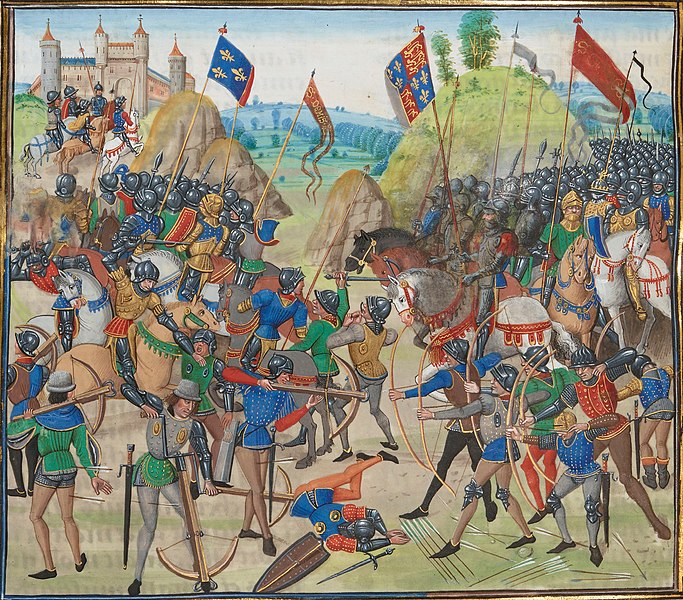

It was no ordinary war, and the Battle of Crécy, which was fought on the 26th of August 1346 in north-east France, was not a simple military engagement either. After the failure of a peace conference in 1344, King Edward III of England launched a campaign through northern France in July 1346, and his force landed in Brittany. Accompanied by his eldest son – also Edward, Prince of Wales (later labelled the Black Prince), the King of England led his troops through Normandy applying the so-called chevauchée aimed at the deliberate devastation of the lands and undermining King Philippe VI of France’s authority as the protector of his realm and his subjects.
King Edward III had enough force for continuing his chevauchée and for laying sieges to a few towns, but not really large enough for an open battle against the full power of France and her allies. On the other hand, the English armies went south as far as Paris, where the panic escalated and the inhabitants of France’s capital started preparations for the defense. Then the English turned back north and met with the French south of Calais, near the town of Crécy-en-Ponthieu. Perhaps such behavior of the English was intended to provoke the King of France into action.
The hills near Crécy guaranteed a defensive position for Edward. Why did the French end up at Crécy? Philippe promulgated the arrière-ban – the formal call to arms for all able-bodied men – both in the north and in the south of France. As a few months earlier the English under the leadership of Henry of Grosmont, Duke of Lancaster, had started a campaign in Gascony, Philippe’s son – Jean de Valois, Duke of Normandy (later King Jean II of France called the Good (le Bon) despite his incompetence as a monarch and a general) – had marched there with an army of 15-20 thousand men. Due to the threat in the north, Philippe ordered his son to lead Jean’s men back to join with his forces. At the time, Jean demonstrated his lack of competence and discipline: he would appear at Crécy, but already after the catastrophe for his father.
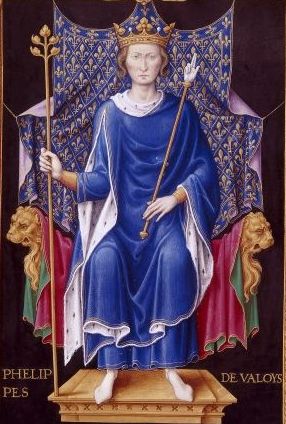
Froissart states that the French troops, which were initially stationed outside of Paris, consisted of 20 thousand men-at-arms, 15 thousand crossbowmen, 60 thousand of commoners, which means that in total the French had 95 thousand men. These figures are implausible: historians debate about the real size of the French army, but according to conservative estimates, they had 8 thousand men-at-arms, 6 thousand crossbowmen, and infantry levies. France had only 2,000 crossbowmen on her payroll in September 1340. So, given the urgency of the king’s call and the offers made to archers in Italy (at the time there were few archers in France, so most of them were hired from abroad), 3-4 thousand more archers from Genoa and Florence could have arrived to the country. It is impossible to assess the number of commoners, but it is irrelevant because they never participated in the battle.
On the 14th of August, Philippe dispatched a messenger to Edward, proposing him a battle. He received a response: Edward would meet them somewhere to the south of the Seine River, but neither time nor place was suggested. What did Edward do? His forces burned down the town of Poissy and retreated north. At this stage, Edward was perhaps trying to compel the French to engage in battle on the territory where the English could have some strategic advantage. Most likely, Philippe hesitated to interpret the actions of his rival claimant for the French crown.
Philippe reached the Somme River, ordering to hold every bridge and fort across the river to entrap the English in the area. The French applied a scorched earth policy during their march, so the English found themselves lacking food. Edward marched on Blanchetaque, and the French attacked, but the English longbowmen annihilated them, letting Edward’s soldiers to advance further north. This setback suffered by the English proves that Edward corrected his plans on spot. As Edward left the Somme region, they found a plenty of food in the area where the French had not used the scorched earth method. It was when Lady Luck began to favor the English.
The English were now at Crécy-en-Ponthieu. Edward decided to prepare a defensive position while the French crossed the Somme and pursued the opponent. Although the actual payroll of the English was lost, the historian Andrew Ayton reconstructed it. He calculated that Edward could have had 14 thousand in total: 2.5 thousand men-at-arms, 5 thousand longbowmen, 3 thousand hobelars (light cavalry and mounted archers), and 3.5 thousand spearmen. The vanguard was commanded by Edward Plantagenet, Prince of Wales, and William Bohun, Earl of Northampton and Constable of the army, as well as Thomas Beauchamp, Earl of Warwick, Marshal of the army. The central wing was led by King Edward III of England together with John de Vere, Earl of Oxford, and Godfrey de Harcourt. The rearguard’s generals were Thomas Hatfield, Bishop of Durham, as well as Richard Fitzalan, Earl of Arundel, and Robert Ufford, Earl of Suffolk.
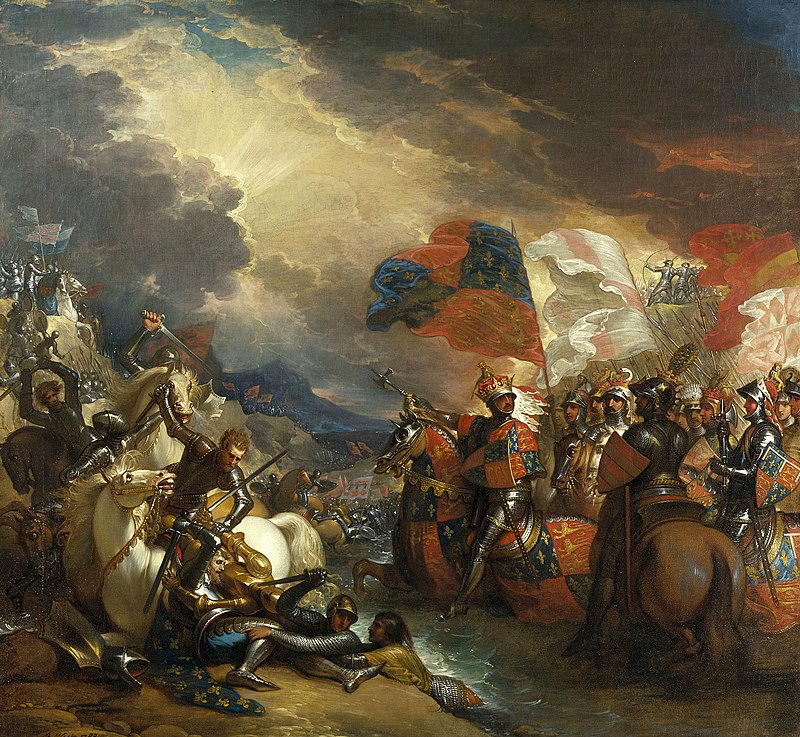
The French were confident in victory as they vastly outnumbered the enemy. For the left wing were responsible: King Jean the Blind of Bohemia, Count de Luxembourg; Count Jean d’Aumale; Count Guy de Saint-Pol; and Jean de Hainault. The central wing was led by the King of France’s friends and relatives: Count Charles II d’Alençon, Philippe’s younger brother; Duke Rudolf de Lorraine, Count Louis de Blois, the king’s nephew; Count Jean de Harcourt; Louis de Nevers, Count of Flanders, Philippe’s cousin. The right wing was commanded by Prince Charles of Bohemia, John’s son, and Count John d’Auxerre. The French rearguard was commanded by King Philippe, as well as Edward de Beaujeu and Charles de Montmorency, both Marshals of France.
After the march during the previous day and night, the French army was tired and not assembled. Many historians claim that Philippe enjoined to attack in any case, although it was getting late in the afternoon and his soldiers were not in the best conditions. Others say that Philippe gave this order with reluctance because the nobles pressured him. My research shows that after the reconnaissance, Philippe consulted with his generals, and they decided to wait until tomorrow. Yet, the situation spiraled out of control: the impatient knights and crossbowmen wanted otherwise. The messengers were sent too late: although the vanguard halted, the others continued advancing, and in the escalating chaos the vanguard, including the cavalry, attacked.
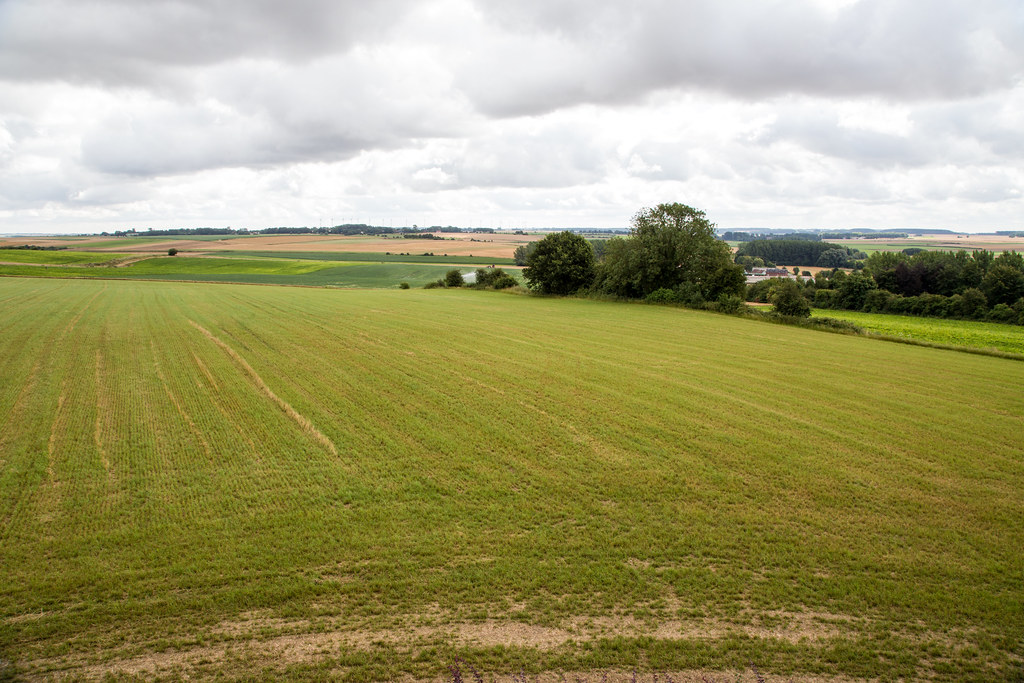
The natural ground at Crécy-en-Ponthieu was the first disadvantage they could not overcome. At the beginning, the cavalry moved along the smooth ground. Later, while crossing the Vallée aux Clercs, they encountered a steep bank, probably the result of farming activities. The bank’s slope rose in places by up to several metres above the valley floor. This obstacle can be compared to an obstacle for the modern driver of a vehicle. The heavily armored medieval horseman could hardly cross the hill at a high speed. Still, the advancement continued, and the French commanders were forced by circumstances to join the others in spite of their liege lord’s previous decision.
The Genoese crossbowmen under the leadership of Carlo Grimaldi and Anton Doria were the closest to the English, and their arrows were the first ones to whistle in the air. Behind them was Charles d’Alençon, in whose division was Jean, the blind King of Bohemia. A man, king or not, must have the soul of a hero if despite his blindness he joined a confrontation! King Philippe and his marshals were leading the rearguard. It was when they discovered that the first bolts of the Italian crossbowmen fell short and did not hurt the enemy. At the same time, the English archers stood like a wall, and the fire from their longbows was severely damaging the French. Doria and Grimaldi instructed their crossbowmen to advance forward thrice, but their bolts still fell short.
The Froissart chronicles describe the response of the English:
“The English archers each stepped forth one pace, drew the bowstring to his ear, and let their arrows fly; so wholly and so thick that it seemed as snow.”
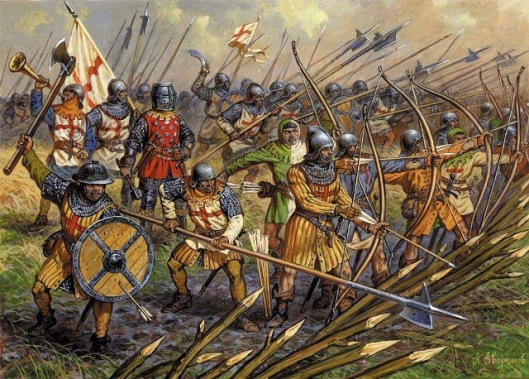
The defeat that the French eventually suffered at Crécy was largely the result of the successful attacks of the English longbowmen. The longbow rate of fire was about 10 to 12 arrows per minute, whereas that of the crossbow was between 3 and 4 bolts per minute. It must be taken into account that the Italian archers were not patriots, but mercenaries who worked for money, while Edward’s archers were professional English and Welsh soldiers. While the archery duel continued, Alençon commenced another cavalry charge, but the morale was already low, and the men were tired – the attack happened in disarray, and again the slope of the hill hindered the progress of the cavalry. Eventually, it all ended with a hand-to-hand combat that was murderous and sanguineous.
The fighting at Crécy went on for hours, well into the night. King Edward observed the battle from the famous windmill on the western ridge of the valley. It was a day of defeat for France: Jean Le Bel (a chronicler from Liege) estimated their losses to be 15-16 thousand men. Thanks to the effectiveness of the longbowmen, the English lost only 300, but this number can be underestimated because history is always written by the winners. It was the day of glorious military baptism for Edward, Prince of Wales, whose divisions were pitiless in the hand-to-hand combat. The later campaigns of the Black Prince in France would come in conflict with the principles of chivalry as he would be burning villages to the ground, pillaging towns and villages.
The French army was crippled. Philippe’s brother – Charles, Count d’Alençon – was killed. More notable French nobles fell in the battle: Louis I, Count of Flanders; Louis II, Count de Blois; Rudolph, Duke de Lorraine; King Jean of Bohemia; and many others. More than 2 thousand heraldic coats were collected from the field by the English. Many French soldiers remained to fight despite their knowledge that they would be slaughtered, for it was glorious to fall in battle defending their sovereign in accordance with the code of chivalry. The French nobility lost many heirs, and for the medieval kingdom this defeat was not only humiliating, but disastrous in the face of the population numbers that were far lower back then than nowadays, and especially in the face of the arrival of the Black Death in 3 years thereafter, which would kill Philippe’s first spouse – Queen Jeanne of France called the Lame (la Boiteuse) due to her leg deformities of unknown kind.
According to Froissart, his own surviving noblemen persuaded King Philippe to leave:
“In the evening the French king, who had left about him no more than a three-score persons, one and other, whereof sir John of Hainault was one, who had remounted once the king, for his horse was slain with an arrow, then he said to the king: ‘Sir, depart hence, for it is time; lose not yourself willfully: if ye have loss at this time, ye shall recover it again another season.’ And so he took the king’s horse by the bridle and led him away in a manner perforce. Then the king rode till he came to the castle of Broye. The gate was closed, because it was by that time dark: then the king called the captain, who came to the walls and said: Who is that calling there this time of night?’ Then the king said: ‘Open your gate quickly, for this is the fortune of France’.”

What were the consequences of Crécy? Obviously, they were good for the English and bad for the French. A triumphant Edward marched to Calais and laid siege to the city, which in 1347 capitulated to the English. By capturing the city, Edward gained another strategic advantage over the French. Calais would remain in the English hands for over 200 years until King Henri II of France would re-conquer it during Queen Mary I of England’s reign. In the same summer, another English army crushed the Scottish forces that invaded England as Philippe requested Scotland’s help due to the existing old Auld Alliance – the Scots were crushed at Neville’s Cross, near Durham, and David II, King of Scotland, was taken prisoner. It seemed that the English could celebrate their victories in France, but the Black Death stopped the fighting temporarily. The military outcome of Crécy was the establishment of the longbow as an extremely effective weapon.
King Philippe VI lived only for 4 years after this battle: he passed away in 1350. His son, King Jean II of France, would later be crushed at the Battle of Poitiers in 1356 and be captured by the English. Jean’s reign proved to be ruinous for France, especially for the state treasury after his eldest son, Charles (later King Charles V of France) paid the ransom for his father. Yet, Jean would later willingly return to England after the escape from the English custody of his other son – Louis d’Anjou. Charles V called the Wise (le Sage) would expel most of the English from the continent, but the subsequent reign of his insane son, King Charles VI of France known as the Mad (le Fou), would be even more calamitous than Jean’s. Eventually, Charles VII of France the Victorious (le Victorieux) with the aid of his mother-in-law, Yolande of Aragon, and initially with the help of Jeanne d’Arc, would overturn the tide of the long war in favor of the French permanently.
All images are in the public domain.
Text © 2020 Olivia Longueville

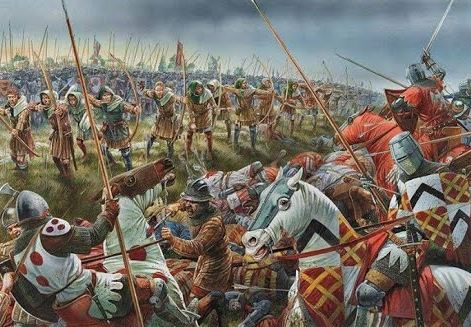




a very interesting read, it would have been useful for me to have a measure of the distances traveled.
Thank you!